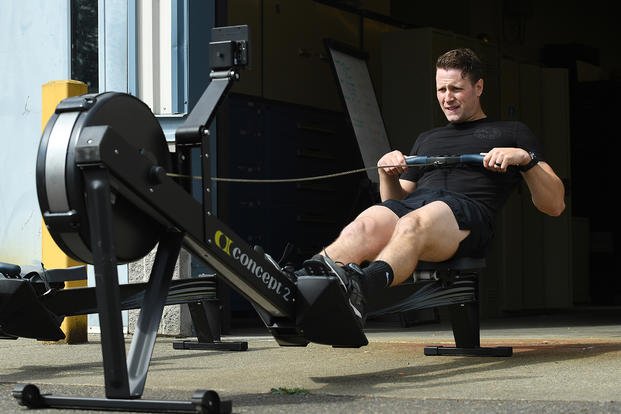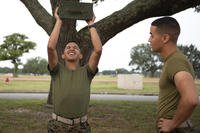To become a member of the Air Force Special Warfare Program, candidates must meet the physical standards on the physical ability and stamina test (PAST).
Here are the specific minimums to qualify for pararescue, combat control technician, special reconnaissance (formerly SOWT) and tactical air control party:
Air Force PAST Standards as of 2020
Minimum physical ability and stamina test (PAST/PST) for Air Force Special Warfare Open Enlistment Air Force Specialty Code, or AFSC.
NOTE: Exercise form is enforced strictly during the PAST and in the training pipeline. Repetitions done without proper form will not be counted.
| AF PAST EVENTS | SWOE:
PJ, CCT, SR, TACP Scores |
| Pull-ups 2 minutes | 8 |
| Sit-ups 2 minutes | 50 |
| Push-ups 2 minutes | 40 |
| 1.5-mile run | 10:20 |
| 2 x 25 meters underwater swim | Pass/fail |
| 500-meter swim | 15:00 |
Pull-ups: Pull-ups are a two-count exercise. Starting position is hanging from a bar, palms facing away from the candidate with no bend in elbows. Hand spread is approximately shoulder width apart. Count one: pull the body up until the Adam's apple clears the top of the bar. Count two: return to starting position. Legs are allowed to bend but must not be kicked or manipulated to aid upward movement. If the candidate falls off, stops or releases the bar, the exercise is terminated.
Sit-ups: Sit-ups are a two-count exercise. Starting position is back flat on the surface, fingers interlocked behind the head, head off the surface and knees bent at approximately a 90-degree angle. Another individual may hold the individual's feet during the exercise. Count one: sit up so that the shoulders are directly above the hip/pelvis area or 90 degrees to surface. Count two: return to the starting position. The exercise is continuous. If the member stops, the exercise is terminated. If the member's buttocks rise from the surface or his fingers are not interlocked behind his head during the repetition, the repetition is not counted.
Push-ups: Push-ups are a two-count exercise. Starting position is hands set apart at shoulder width with arms straight and directly below the chest on the surface. The legs are extended, while back and legs remain straight. Count one: Lower the chest until the elbows are bent at a 90-degree or lower angle. Count two: Return to the starting position. The only authorized rest position is the starting position. If the knees touch the ground, the exercise is terminated. The member will not raise his buttocks in the air, sag his middle to the surface or raise any hand or foot from their starting position. If a hand or foot is raised, the exercise is terminated.
1.5-mile run: Physical training (PT) clothes and good running shoes are the only required items. The run must be nonstop. If a member stops anytime during this run, the test will be stopped and considered a failure. Members will be given a 10-minute break before the next event. The test should be conducted on a measured running track.
2 x 25-meter underwater swim: Provide the member three minutes of rest between underwaters. If members surface or break the water surface during any portion of the swim, the test will be stopped and considered a failure. Swimsuits and swim goggles or scuba mask are the only equipment items allowed. After completion of the underwater swim, allow a 10-minute rest before next event.
500-meter surface swim: This swim is conducted using the freestyle, breaststroke or sidestroke. The swim is continuous. If a member stops at any time during the swim, the test will end and be considered a failure for the entire PAST. Swimsuit and goggles or scuba mask are the only equipment allowed. After completion of the swim, allow a 30-minute rest before the next event.
Calisthenics: Four calisthenics exercises are evaluated, each with specific time parameters and specific exercise form mechanics. All members will exercise either to muscle failure or time completion, whichever occurs first. The intent is to have members do as many "good-form" repetitions in the time allotted or when muscle failure is reached. Allow a three-minute rest between each calisthenics exercise.
After basic military training (BMT), you will attend the new Air Force Special Warfare Prep Course (formerly known as battlefield airman prep course). However, before you ever leave for basic, you will have some training and early preparation before departing BMT.
While in the delayed entry program, a group of former Air Force Special Ops trainers and mentors will make sure you are meeting the standard before you depart for BMT. See the official site to find local trainers, mentors and recruiters to help you prepare for Air Force Special Warfare jobs such as pararescue, combat controller, tactical air control party, SERE, SR and EOD.
The Air Force Special Warfare prep course is for the formerly named “battlefield airmen” and is an eight-week course designed for BMT graduates who have selected and qualified for the Air Force Special Warfare career field. Its purpose is to assist rebuilding an elevated physical level after BMT and adequately prepare these new airmen for their following selection training pipelines.
Once in the candidate course, candidates will be challenged physically for 10 weeks at Joint Base San Antonio-Lackland, Texas. The program consists of extensive physical training with swimming, pool skills, running, weight training, calisthenics and obstacle courses. Educational training such as medical and diving terminology, CPR and weapons qualifications are also part of the candidate course. Once a candidate finishes this phase of the training, they will have undergone some of the most challenging water survival training in the U.S. military.
Learn More About Air Force Special Tactics
Training is extremely challenging physically and mentally, and you will be one of the most highly trained combat medics or air traffic controllers in the world, able to handle the most stressful situations with ease. Hats off to those who risk their lives so "That Others May Live."
Find Available Special Operations Opportunities
More Air Force Special Forces Articles:
Helicopter Rescue Swimmer Training
All Air Force Special Forces Articles
Many of my favorite PT programs to train for the Air Force Special Tactics teams can be found in the following Military.com links:
Other Air Force Fitness Articles:
Air Force Basic Training PFT Requirements
Air Force Fitness and Weight Standards
Air Force Pre-Boot Camp Workout
Performing for the Special Forces
Stew Smith is a former Navy SEAL and fitness author certified as a Strength and Conditioning Specialist (CSCS) with the National Strength and Conditioning Association. Visit his Fitness eBook store if you’re looking to start a workout program to create a healthy lifestyle. Send your fitness questions to stew@stewsmith.com.
Want to Learn More About Military Life?
Whether you're thinking of joining the military, looking for fitness and basic training tips, or keeping up with military life and benefits, Military.com has you covered. Subscribe to Military.com to have military news, updates and resources delivered directly to your inbox.



















